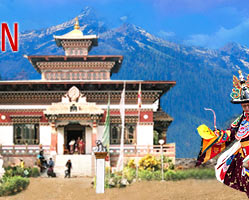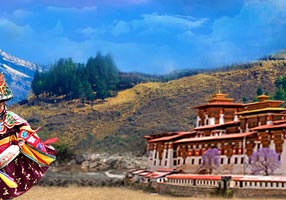The Raven is the Bhutan's national bird. It represents one of the most powerful deities of the country, Jarog Dongchen. Raven is thus known in the local language as ‘Jarog’. The Royal Raven Crown or Druk Gyalpo represents Bhutan's reverence for these birds and the faith of Bhutanese in their protective deity. Jarog Dongchen along with Yeshey Gonpo (Mahakala) and Palden Lhamo (Mahakali) form the Divine Trinity, who protects the King and the people of Bhutan from harm and safeguard their well being. At one time, it was a capital crime to kill a Raven in Bhutan. One can still see ravens nesting in monasteries and dzongs throughout Bhutan.
The biological name of Raven is Corvus Corax Tibetanus and is quite similar to the Crow or Corvus Macrorhynchos that is also common in Bhutan. The crow however has larger bill but overall, raven is much larger than a crow and is about 28 inches long. Raven’s tail looks like a wedge, its upper peak has bristles and there are prominent hackles on its throat. Hackles are long, shiny and pointed feather that can be found on raven’s throat and best. Both male and female ravens look alike and are jet blue-black in color. They are commonly found in upland habitation and in alpine and trans-Himalayan regions. During winters, they migrate to lower lands standing at 2300 m. They reside in high altitudes of Tibet, Sikkim, Ladakh and Bhutan.
You can spot a raven at Damthang, Cherithang, Jagothang, Lingshi and Chebesa in Western Bhutan; Bumthang, Dur and Pegula in Central Bhutan and Singye Dzong and surrounding areas in Eastern Bhutan. They can be seen generally in pairs or huddling together by dozens. By nature, ravens are wild, wary, bold and suspicious and love to fly. They are carrions like vultures and can feed on vegetable or animal matter, dead or alive. You can even see them doing acrobatic stunts in high winds and it is not rare to see a raven doing tricks like twisting, turning, sides slipping, looping the loop and nose-diving. Female ravens start building the nest around February from twigs while the make ravens bring moss and hair to make it comfortable for the young ones. Their nests can last for years and only need minor renovations.
Hens give about 5 to 6 eggs at once and incubate them, only to be occasionally relieved by the males. The young ones hatch in 19 to 23 days and for 40 to 42 days, they remain in the nest and are looked after and fed by adults with the food brought in their special throat sac. It has been observed that even the young ones attack large predators trying to approach their nest bravely. It is believed that the guardian Deity, Mahakala, takes the form of a raven to guide the country’s unifier, Shabdrung Ngawang Namgyel, to Bhutan. Namgyel founded Bhutan in the 17th century. The raven-headed form of Mahakala is known as Lego Jaro Dongchen. In 1885, the Trongsa Penlop Jigme Namgyal (father of HM Ugyen Wangchuck, the first king of Bhutan) wore the Raven Crown to the war with the British as his helmet. Since then, it became a model for all future crowns of the Wangchuk dynasty.




